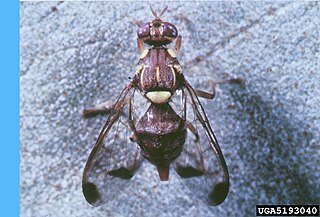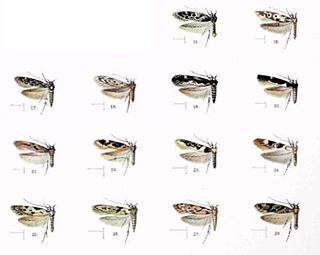
Yellowjacket or yellow jacket is the common name in North America for predatory social wasps of the genera Vespula and Dolichovespula. Members of these genera are known simply as "wasps" in other English-speaking countries. Most of these are black and yellow like the eastern yellowjacket Vespula maculifrons and the aerial yellowjacket Dolichovespula arenaria; some are black and white like the bald-faced hornet, Dolichovespula maculata. Others may have the abdomen background color red instead of black. They can be identified by their distinctive markings, their occurrence only in colonies, and a characteristic, rapid, side-to-side flight pattern prior to landing. All females are capable of stinging. Yellowjackets are important predators of pest insects.

The Pyralidae, commonly called pyralid moths, snout moths or grass moths, are a family of Lepidoptera in the ditrysian superfamily Pyraloidea. In many classifications, the grass moths (Crambidae) are included in the Pyralidae as a subfamily, making the combined group one of the largest families in the Lepidoptera. The latest review by Eugene G. Munroe and Maria Alma Solis retain the Crambidae as a full family of Pyraloidea.

Dermestidae are a family of Coleoptera that are commonly referred to as skin beetles. Other common names include larder beetle, hide or leather beetles, carpet beetles, and khapra beetles. There are approximately 500 to 700 species worldwide. They can range in size from 1 to 12 mm. Key characteristics for adults are round oval shaped bodies covered in scales or setae. The usually clubbed antennae fit into deep grooves. The hind femora also fit into recesses of the coxa. Larvae are scarabaeiform and also have setae.

The Momphidae, or mompha moths, is a family of moths with some 115 described species. It was described by Gottlieb August Wilhelm Herrich-Schäffer in 1857. These moths tend to be rather small with a wingspan of up to 21 mm. The wings are held folded over the body at rest. The larvae are concealed feeders, either as leaf miners or within seeds or stems.

Thyrocopa is a genus of moths in the family Xyloryctidae endemic to Hawaii. The taxon has approximately forty species, including some flightless species.

Simosyrphus grandicornis is an Australasian species of hoverfly, and is one of the two most common hoverflies in Australia, alongside Melangyna viridiceps. It has been introduced to a number of Polynesian Islands and Hawaii.

Cellana sandwicensis, common name the yellow-foot ʻopihi, is a species of edible true limpet, a marine gastropod mollusc in the family Nacellidae, one of the families of true limpets.

Bactrocera cucurbitae, the melon fly, is a fruit fly of the family Tephritidae. It is a serious agricultural pest, particularly in Hawaii.

Scotorythra paludicola, the koa looper moth, is a moth of the family Geometridae. It was first described by Arthur Gardiner Butler in 1879. It is endemic to the Hawaiian islands of Kauai, Oahu, Maui and Hawaii.

Hyposmocoma chilonella is a species of moth of the family Cosmopterigidae. It was first described by Lord Walsingham in 1907. It is endemic to the Hawaiian islands of Kauai, Oahu, Maui, Molokai and Hawaii.

Hyposmocoma alliterata is a species of moth of the family Cosmopterigidae. It was first described by Lord Walsingham in 1907. It is endemic to the Hawaiian islands of Oahu, Molokai, Maui and Hawaii. This species is thought to range from the lowlands to the highlands, where it is most abundant.

Hyposmocoma liturata is a species of moth of the family Cosmopterigidae. It was first described by Lord Walsingham in 1907. It is endemic to the Hawaiian islands of Oahu and Hawaii. The type locality is Kona, where it was collected at an elevation of 4,000 feet (1,200 m).
Schrankia altivolans is a species of moth of the family Erebidae. It occurs in epigean habitats on Kauai, Oahu, Molokai, Lanai, Maui and Hawaii. It also occasionally occurs in caves on at least Maui and Hawaii.
Praeacedes is a monotypic moth genus in the family Tineidae first described by Hans Georg Amsel in 1954. Its only species, Praeacedes atomosella, was first described by Francis Walker in 1863. It has a wide range and has been recorded from Europe, Australia, Hawaii, India, Malaysia, Solomon Islands, Easter Island, Mauritius, Madagascar, Réunion, South America and North America. The species has commonly been misidentified in various parts of the world.
Dichomeris acuminata, the alfalfa leaf tier, is a moth of the family Gelechiidae. It was first described by Otto Staudinger in 1876. It is a widely distributed species, being known from India, Myanmar, and Sri Lanka southwest to the Seychelles, Mauritius and Réunion and on to Egypt, east and South Africa and southern Europe. Eastward from India it extends through Indonesia and Malaysia to Taiwan and Australia. It is also found in Japan, the West Indies, North America and Hawaii.

Hellula undalis, the cabbage webworm or Old World webworm, is a moth of the family Crambidae. It is a widespread species which is found from Europe across Asia to the Pacific. It was first described from Italy.

Omphisa anastomosalis, the sweetpotato vineborer, is a moth of the family Crambidae. It is widespread, with records including the Philippines, Indonesia, New Guinea, India, Sri Lanka, Malaysia, Taiwan, Hawaii, Vietnam, China, Japan, Cambodia, Laos, Burma and Thailand.

Parapoynx fluctuosalis or Fluctuating China-mark or Waved China-mark, is a moth of the family Crambidae. It is a widespread species, known from Africa, India, Sri Lanka, China, Japan, Malaysia, Taiwan, Guam, Hawaii, Fiji, Australia and the Galápagos Islands. It is also an introduced species in Europe, where it has been recorded from Great Britain, the Iberian Peninsula and Sardinia.

Cryptophlebia illepida is a species of moth in the family Tortricidae that is endemic to the islands of Kauaʻi, Oʻahu, Molokaʻi, Maui, Lānaʻi and Hawaiʻi. Common names include koa seedworm, klu tortricid, koa seed moth, litchi borer, litchi moth, macadamia nut borer and macadamia nut moth. It was first described by Arthur Gardiner Butler in 1882.

Herpetogramma licarsisalis, the grass webworm or pale sod-webworm, is a moth of the family Crambidae. It is native to most of the old world tropics, including New Zealand, Hong Kong and Queensland. It is an introduced species in many other parts of the world, including Hawaii and the Canary Islands, as well as India and Sri Lanka

















